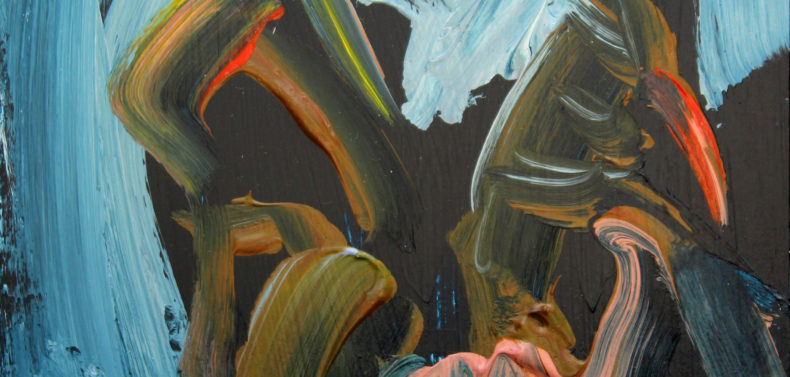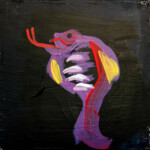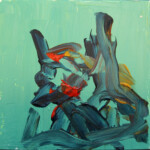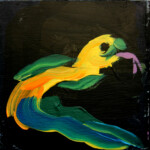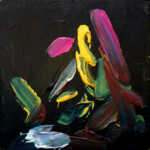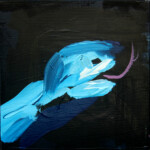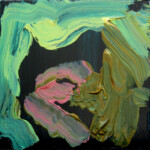The Willson Center for Humanities and Arts, in partnership with the UGA Graduate School, UGA Arts Council, Franklin College of Arts and Sciences, and Flagpole, has awarded 34 micro-fellowships in its Shelter Projects program. The $500 fellowships support graduate students and community-based artists and practitioners in the creation of shareable reflections on their experience of the current pandemic through the arts and humanities.
Statement by Will Eskridge: This project consists of a series of paintings, films, songs, all completed within or lasting 20 seconds. The purpose of this project is to recall the Center For Disease Control’s recommendation of washing one’s hands for at least 20 seconds to protect from and reduce spreading of COVID-19. The pieces serve as a creative reminder to audiences of this guideline. The pieces consist of focusing on subjects revolving around the pandemic. Quick, abstract portraits of bats and snakes painted in positive and bright colors to counter their wrongful blame for the pandemic. Songs expressing the fun delirium that can set in from quarantine. And short films focusing on the positivity of staying home with loved ones. Finally the hashtag #20secondsart was created for social media purposes to encourage other creatives to take part and help spread the information along with their art.
Flagpole: Your body of work often focuses on misunderstood creatures—in this case bats and snakes, who have both been suspected of being the original source of SARS-CoV-2. What are your feelings about how those conversations were handled, along with the subsequent blame, fear, xenophobia, etc.?
Will Eskridge: It honestly crushed me, because it only amplifies the fears and myths about bats. The Chiroptera order already face so much persecution with many species staring extinction in the eye, yet they are one of the most important animals on the planet. Say goodbye to tequila, balsa wood, mango and more. As the news started coming in, I also listened closely to virologists, bat biologists and conservationists. I could bore you with statistics and facts from all of these scientists on how this disease and others (including rabies) are not the fault of bats or snakes. Outbreaks of these new diseases have been linked to human interference of nature. Bats didn’t and don’t “come after” humans and say “Hey there, I’ve got a new virus for ya!” Humans came to them. They are wild creatures like coyotes, bears and snakes. They and their habitat should not be encroached upon if we want to see less and less novel viruses and a healthier earth. Like many issues in the world, I think society wants someone or something to blame to take it off of themselves.
Flagpole: Since your Shelter Project, you also created a series of paintings called “Pärty Animalz!” Can you tell us a bit about that collection?
WE: Pärty Animalz! is my apex for this crazy, strange year. With such uphill battles everyone faced this year, I ultimately wanted to send out a kind of celebration and not a “WTF” into the world. These uphill battles helped me fantasize about a group of bad reputation animals trying to get into the “popular animals” party, only to be turned away. So instead of moping about they decide, “What the hell, let’s just have our own party!” So they end up watching movies, spinning records and eating pizza! It’s a bit of a lemons into lemonade narrative.
Flagpole: Bats seem to be one of your more popular subjects, appearing in the series “Pärty Animalz!” and “Confectionery Outcasts,” as well as your solo exhibition “Central Nervous Breakdown” at tiny ATH gallery last year. What is it that draws you to bats?
WE: My affinity with bats is a culmination of a few different intersections. The main thread began from working at my father’s veterinary practice at a young age in North Carolina and caring for rejected animals. All of the pets we guarded were ones that people left behind and never came back to pick up. This instilled a deep connection and empathy towards the “outcast.” And instead of being feared, I was curious to understand. I think the scapegoating is mainly from most bats being nocturnal, being related to the night, and thus mysterious. Or possibly even more straight ahead: Night resembles darkness, death and evil in many cultures. Humans fear the unknown. Speaking of the night, another major thread in my big quilt of outcast animals is my lifelong passion for Halloween and horror movies. Halloween and Hollywood have both done their fair share of pushing the stigma on bats, but I have found a path with fellow bat lovers that embrace it, educate and have fun!
Flagpole: Earlier this year, three of your paintings appeared in an episode of Netflix’s “Love is Blind.” How did this happen, and what was in like to see your work in reality TV? Do you have any advice for artists hoping to land their work in film sets?
WE: What a fantastic opportunity! A couple of years ago, a few of my paintings had been accepted into juried shows at Kai Lin Art in Atlanta. Because of this, they invited me to show some new work for one of their group shows. Over the course of the show’s run, the producers for “Love is Blind” had acquired the space as the backdrop for one of the episodes, and I guess whoever was the set decorator liked my work enough to feature it for that intense scene. I was surrealistically over the moon about it! My wife and I were watching the episode (I wasn’t sure which one it would show up in) and couldn’t believe. Almost like an out of body experience. With my jaw open, she said to me “You know they pick your paintings on purpose for this scene.” I love film and TV and one of my business goals is to get more work featured on sets, so I was on cloud nine. My advice for any endeavor is to make a weekly habit of research, outreach and follow up. Always follow up.
Like what you just read? Support Flagpole by making a donation today. Every dollar you give helps fund our ongoing mission to provide Athens with quality, independent journalism.



